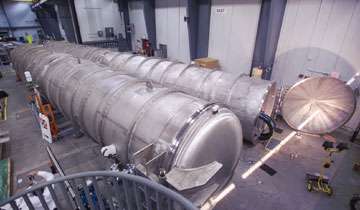ORNL's High Flux Isotope Reactor prepares to make 'cold' neutrons

The High Flux Isotope Reactor at the Department of Energy's Oak Ridge National Laboratory has passed a major milestone in its quest to become one of the world's leading sources of "cold" neutrons for advanced scientific research.
Once fully operational, the reactor will combine with the laboratory's Spallation Neutron Source to make Oak Ridge the world's center for neutron sciences.
In tests this week, powerful refrigeration systems designed to cool the reactor's neutron beams to 20 K (minus 425° Fahrenheit) operated "just as we expected," said Kelly Beierschmitt, HFIR Executive Director.
"We now have a working cryogenic system to cool the neutrons at HFIR," Beierschmitt said. "This is a huge step toward completion of a truly world-class research facility, extending ORNL's leadership in the study of materials with neutron sciences.
"We will do systems testing and safety reviews over the next couple of months to prepare the reactor to resume routine operations. This is a very exciting time here at our reactor."
Neutrons are vital to research in physics, chemistry, engineering and other materials-related fields. At room temperature, they are ideal for use in special instruments to illuminate the atomic structure and dynamics of hard, dense materials.
Cooling them -- in this case to temperatures about 10 times colder than the South Pole -- slows their speed and lengthens their wavelength, which works better for studying the larger structural components of "soft" materials such as proteins and polymers or to analyze materials with certain magnetic properties.
HFIR's cold source will complement the capabilities of the recently completed Spallation Neutron Source, the world's premier neutron science facility.
While SNS also has cold-neutron capabilities, the continuous neutron flow from a reactor such as HFIR, as opposed to pulsed beams from accelerators like SNS, offers advantages for certain types of neutron experiments.
"ORNL will be unique in the world in having both high-intensity pulsed and continuous cold neutron sources," Steve Nagler, interim director of ORNL's Center for Neutron Scattering, said. "The neutron science community is eager to utilize these extraordinary capabilities, and we will soon be ready to provide them."
HFIR's continuous cold neutron source will rival the reactor at France's Institut Laue Langevin, generally considered as a world leader in the field, Nagler said.
Built in 1966, HFIR continues to be one of the nation's leading producers of isotopes for medical uses and other applications. The new cold neutron source is part of a $65 million DOE Office of Science-funded renovation that represents a major new direction for the reactor and revitalizes its role to the nation's science and research community.
"This is a significant milestone that allows the Office of Science to enhance our national laboratory system's infrastructure, enabling researchers to have additional capabilities to conduct experiments and produce world-class science," said Pat Dehmer, associate director of Basic Energy Sciences for DOE's Office of Science.
The fully instrumented HFIR will include 15 state-of-the-art neutron-scattering instruments, seven designed exclusively for cold neutron experiments; new computer control systems; and a new guide hall facility. Particularly prominent in the guide hall are the two new small-angle neutron scattering instruments, each terminating in a 70-foot long evacuated cylinder containing a large moveable neutron detector.
Source: Oak Ridge National Laboratory





















